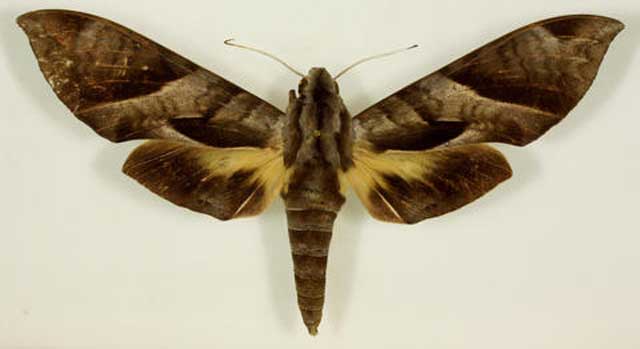Eumorpha zaplutus
|
|
Updated as per Sphingidae Taxonomic Inventory, Ian Kitching, March 16, 2017
|
Eumorpha zaplutus
you-MOR-fuhMzah-PLOO-tus
Haxaire, 2015

Eumorpha zaplutus HT male, Calabaza, Satipo, Junin, Peru,
courtesy of Jean Haxaire, via Creative Commons,
as per Sphingidae Taxonomic Inventory, Ian Kitching.
This site has been created by Bill Oehlke.
Comments, suggestions and/or additional information are welcomed by Bill.
| TAXONOMY:
Superfamily: Sphingoidea, Dyar, 1902
Family: Sphingidae, Latreille, 1802
Subfamily: Macroglossinae, Harris, 1839
Tribe: Philampelini, Burmeister
Genus: Eumorpha, Hubner, [1807]
Species: zaplutus, Haxaire, 2015 |
DISTRIBUTION:
Eumorpha zaplutus (forewing length = approx. mm) flies in
Peru: Junin: Satipo: Calabaza; and Bolivia, at elevations near 2000m.
FLIGHT TIMES AND PREFERRED FOOD PLANTS:
Eumorpha zaplutus adults are on the wing in July. Possibly there are additional flight months.
Eumorpha zaplutus larvae probably feed upon Vitis.
ECLOSION, SCENTING AND MATING:
Pupae wiggle to surface just prior to eclosion. Females call at night, and males fly into
the wind to pick up and track the pheromone plume.
EGGS, LARVAE AND PUPAE:
Larval Food Plants
Listed below are anticipated primary food plant(s) and alternate food plants. It is hoped that this alphabetical listing followed by the
common name of the foodplant will prove useful. The list is not exhaustive. Experimenting with closely related foodplants is worthwhile.
The genus name "Eumorpha" means well-formed.
The species choice of "zaplutus" is is unknown to me.
The pronunciation of scientific names is troublesome for many. The "suggestion" at the top of the page is merely a suggestion. It is based on
commonly accepted English pronunciation of Greek names and/or some fairly well accepted "rules" for latinized scientific names.
The suggested pronunciations, on this page and on other pages, are primarily put forward to assist those who hear with internal ears as they read.
There are many collectors from different countries whose intonations and accents would be different.
The usual practice for names chosen to honour a contemporary, is to say the name, followed by "eye".
Return to Philampelini Index
Return to Sphingidae Index
